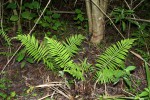Christella chaseana (Schelpe) Holttum
Synonyms |
Thelypteris chaseana Schelpe |
|---|---|
Common name |
|
Description |
Rhizome creeping, up to 20 mm in diameter; rhizome scales lanceolate in outline, apex tapering to a point, margin entire, up to 11 mm long, brown, thinly pilose. Fronds monomorphic, closely spaced, erect or slightly arching, not proliferous, herbaceous. Stipe 30-63 cm long, pale brown, hairless with dark brown scales near the base. Lamina deeply 2-pinnatifid, narrowly elliptic to lanceolate in outline, apex tapering to a point with a deeply pinnatifid terminal segment, basal 3-5 pairs of pinnae reduced and deflexed, up to 30-80 × 14-40 cm; pinnae narrowly oblong, 8-20 x 1.8-2.3 cm; ultimate lobes narrowly oblong, slightly falcate, apex rounded, basal acroscopic lobe enlarged and sometimes overlapping the rhachis, 5-10 x 2-3.5 mm, both surfaces hairy, more so along the veins, costa and costules; veins 1 pair meeting at the sinus; rhachis strawcoloured, pilose. Sori round, up to 16 per lobe; indusia small,subcircular to kidney-shaped with long white hairs. |
Notes | Christella guenziana closely resembles C. chaseana but has an erect rhizome. C. microbasis has glandular hairs on the lamina undersurface as well as yellow glands on the indusia.
|
Derivation | chaseana: named for Norman C. Chase (1888 - 1970), one of our foremost collectors of Zimbabwean plants, particularly of ferns. |
Habitat | Stream and riverbanks in mixed deciduous woodland and riverine forest fringes, among rocks in grassland, near water allthough not always along perennial streams. |
Distribution worldwide | See african distribution. |
Distribution in Africa |
Angola, Cameroon, Congo, Ethiopia, Kenya, Malawi, Mozambique, Namibia, South Africa, Tanzania , Uganda, Zambia, Zimbabwe. |
Growth form |
Terrestrial. |
Literature |
|
